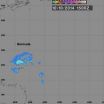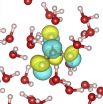(Press-News.org) AMES, Iowa – News of a school shooting or a homicide involving a teenage suspect always leads to the question of why? It is human nature to want an explanation or someone to blame, and policymakers try to pinpoint a cause in an effort to prevent it from happening again. But too often, the speculation or rush to judgment clouds reality, said Matt DeLisi, a professor of sociology and criminal justice at Iowa State University.
"Anytime you have violence, such as a school shooting, people gravitate to single-item explanations that cite mental illness, guns, bullying or peer pressure," DeLisi said. "All of these factors likely have an influence, but there's really no silver bullet."
Instead, DeLisi and his colleagues at the University of Texas at Dallas found a handful of risk factors that are predictors, or distinguish homicide youth offenders from other serious offenders. Age was a factor, but those charged with murder also had a significantly lower IQ, higher exposure to violence, perceived that they lived in a violent or chaotic neighborhood, and were more likely to carry a gun. The study is published in the journal Youth Violence and Juvenile Justice.
Of the more than 1,300 serious youth offenders included in the study, only 18 were charged with some type of murder, which included attempted murder or involuntary manslaughter. Researchers examined 43 background factors associated with delinquency, such as psychopathy, prior arrests, family criminal history, substance abuse and gang activity.
The fact that there were more similarities than differences between homicide and non-homicide offenders is further evidence of the challenge to identify one predicting factor, DeLisi said. It also dispels some of the stereotypes. For example, offenders charged with murder were more psychopathic than other youth offenders, but the difference was not significant enough to make it a predictor of homicide.
"When you think about these youth offenders, who are very problematic and very delinquent, there are dozens and dozens of risk factors and lots of bad news," DeLisi said. "It's very hard to find those factors that are going to significantly predict which one of these youth will or won't commit a homicide."
Understanding risk factors
Of the five risk factors identified in the study, exposure to violence had the most significant difference between the two groups, DeLisi said. It is important to note that researchers looked at direct observational exposure to violence, not media violence or vicarious exposure. Offenders were asked whether they had ever witnessed a rape, shooting or an assault, and if they had ever been chased and thought they would be seriously hurt.
"The homicide offenders came from much more impoverished areas, with more violence day in and day out that they seem to be disengaged. When you observe that much violence it becomes very normal to you," DeLisi said. "It's really the worst of all worlds. They live in bad neighborhoods; have a lot of family dysfunction and family members who are involved in crime or who are victims of homicide."
DeLisi also pointed out that offenders with low IQ levels generally lack the verbal skills to effectively communicate or diffuse a situation. As a result, they may resort to violence. If you couple that with the fact that they are also more likely to carry a gun, it is easy to see how a situation can escalate to deadly violence, DeLisi said.
Less than 2 percent of youth offenders in the study were charged with some type of murder, which is a good thing, DeLisi said. However, a larger sample size could yield different results. Understanding the risk factors for youth offenders is important to preventing future violence. DeLisi said there are several studies that show people who commit murder are more likely to do it again. Still, there is no way to predict with 100 percent certainty which offenders will reoffend.
"It's very easy to predict the future in hindsight and it's impossible to do it otherwise," DeLisi said. "From a policy standpoint, that's why it's so difficult to decide who to keep locked up for a longer period of time. You may have a hunch that an offender might be more violent, but you don't always know."
INFORMATION:
CHICAGO --- A nano-sized discovery by Northwestern Medicine® scientists helps explain how bipolar disorder affects the brain and could one day lead to new drug therapies to treat the mental illness.
Scientists used a new super-resolution imaging method -- the same method recognized with the 2014 Nobel Prize in chemistry -- to peer deep into brain tissue from mice with bipolar-like behaviors. In the synapses (where communication between brain cells occurs), they discovered tiny "nanodomain" structures with concentrated levels of ANK3 -- the gene most strongly associated ...
VIDEO:
This rainfall analysis showed that Gonzalo generated several areas over the Atlantic Ocean where rainfall totals topped 12 inches (red). Fay's maximum rainfall appeared between 4 and 8 inches (green)....
Click here for more information.
The Tropical Rainfall Measuring Mission or TRMM satellite can estimate rainfall rates from its orbit in space and that data is used to create a rainfall analysis and calculate total rainfall for weather events in the tropics. NASA used ...
Tropical Storm Ana was being battered by wind shear when NASA's Terra satellite passed overhead and saw the bulk of showers and thunderstorms pushed north and east of the center.
NASA's Terra satellite flew over Tropical Storm Ana as it was moving past Hawaii on Oct. 21 at 21:30 UTC (5:30 p.m. EDT) and the Moderate Resolution Imaging Spectroradiometer (MODIS) instrument took a visible picture of the storm. The MODIS image showed that the strong southwesterly wind shear that was affecting the storm on Oct. 20 continued through Oct. 21 as the bulk of clouds and showers ...
WORCESTER, MA –Using an innovative exome sequencing strategy, a team of international scientists led by John Landers, PhD, at the University of Massachusetts Medical School has shown that TUBA4A, the gene encoding the Tubulin Alpha 4A protein, is associated with familial amyotrophic lateral sclerosis (ALS), a fatal neurological disorder also known as Lou Gehrig's Disease. Details of the study were published today in Neuron.
Exome sequencing, in contrast to whole genome sequencing, relies on sequencing only the protein-coding genes in a genome and has been an effective ...
The Bureau of Reclamation has released a report summarizing six years of testing coatings to control the attachment of quagga and zebra mussels to water and power facilities. Since the study began in 2008, Reclamation has tested more than 100 coatings and materials.
"Controlling attachment of invasive quagga and zebra mussels on Bureau of Reclamation facilities is important to ensure water delivery and hydropower generation," principal researcher Allen Skaja said. "Though we have tested many different coatings, three durable foul-release coatings are showing promise ...
Worcester, Mass. – People paralyzed by spinal cord injuries lose mechanical strength in their leg bones faster, and more significantly, than previously believed, putting them at greater risk for fractures from minor stresses, according to a new study by a research team at Worcester Polytechnic Institute (WPI).
The results suggest that physicians need to begin therapies for spinal cord injury patients sooner to maintain bone mass and strength. The data also serve as warning to physicians treating patients with osteoporosis to think beyond the standard bone density ...
Combining a PET scanner with a new chemical tracer that selectively tags specific types of bacteria, Johns Hopkins researchers working with mice report they have devised a way to detect and monitor in real time infections with dangerous Gram-negative bacteria. These increasingly drug-resistant bacteria are responsible for a range of diseases, including fatal pneumonias and various bloodstream or solid-organ infections acquired in and outside the hospital.
"What we have produced is essentially a system that localizes the epicenter of infection and provides real-time tracking ...
The National Institute of Standards and Technology (NIST) has published the final version of the US Government Cloud Computing Technology Roadmap, Volumes I and II. The roadmap focuses on strategic and tactical objectives to support the federal government's accelerated adoption of cloud computing. This final document reflects the input from more than 200 comments on the initial draft received from around the world.
The roadmap leverages the strengths and resources of government, industry, academia and standards development organizations to support technology innovation ...
A University of Colorado Cancer Center study recently published in the journal Prostate offers compelling evidence that inflammation may be the link between Vitamin D and prostate cancer. Specifically, the study shows that the gene GDF-15, known to be upregulated by Vitamin D, is notably absent in samples of human prostate cancer driven by inflammation.
"When you take Vitamin D and put it on prostate cancer cells, it inhibits their growth. But it hasn't been proven as an anti-cancer agent. We wanted to understand what genes Vitamin D is turning on or off in prostate cancer ...
Though it garners few public headlines, carbonic acid, the hydrated form of carbon dioxide, is critical to both the health of the atmosphere and the human body. However, because it exists for only a fraction of a second before changing into a mix of hydrogen and bicarbonate ions, carbonic acid has remained an enigma. A new study by Berkeley Lab researchers, has yielded valuable new information about carbonic acid with important implications for both geological and biological concerns.
Richard Saykally, a chemist with Berkeley Lab's Chemical Sciences Division and a professor ...




